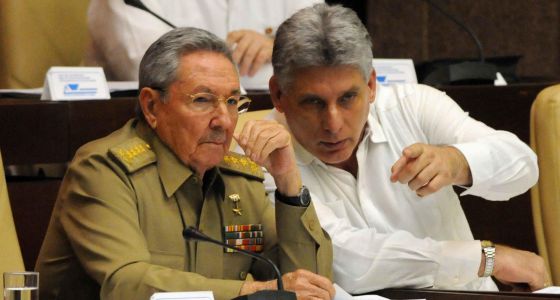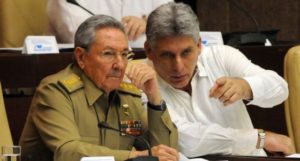MIGUEL DÍAZ-CANEL, EVENTUALLY POLITICAL SUCCESSOR OF RAÚL CASTRO IN CUBA.
Miguel Diaz-Canel appears as the natural political heir of the current ruler. The first Vice President is the last survivor of the so-called “dolphins of Castrism”. Protected from Raul Castro emerges as his eventual successor in Cuba.
Tall, greying, they say it is a simple man. And many in Cuba compares with the actor Richard Gere. However, he just smiles and does not protrude by charisma or oratory. But with the death of Fidel Castro and the promise of his brother Raul to leave the Presidency of Cuba in 2018, now foci are running towards him, first Vice President Miguel Diaz-Canel, who is emerging as the natural political heir of the current ruler of the island.
Born in the town of Placetas, in the central province of Villa Clara, on April 20, 1960, Diaz-Canel is the first leader who was born after the triumph of the 1959 Revolution to reach the post of first Vice-President of the Council of State, the Supreme executive body of the island, Raúl Castro presiding.
His father worked for a brewery, and his mother was a primary school teacher, reported to The New York Times by someone close to the family. After graduating as an electronic engineer by the Central University of Las Villas in 1982, he entered in the revolutionary armed forces (FAR), where it was kept until 1985. In April of that year, entered as a professor to the University where it was formed, where he also served as leader of the Union of young communists (UJC).
“I used to be very popular among women, perceived as a handsome, tall, ‘cool’,” said the Times Domingo Amuchastegui, former official of the regime, who briefly shared with Diaz-Canel at the beginning of his career. “Even my daughter reminds him how superpopular among youngsters in the 1980s”, he said.
Their successful missions in Nicaragua and in the policy as first Secretary in the villages earned in 2003 promotion to the Politburo of the PCC, becoming the youngest member of this select and powerful body of the Cuban nomenclature. His income was due to the proposal of the then Minister of the armed forces., Raúl Castro, who spared no praise to his protege: “It has a high sense of collective work and demanding with subordinates and preaches by example in the effort to overcome on a daily basis”.
But his breakthrough gave it in 2013, with 52 years, when he was appointed first Vice-President of Cuba instead of the historical Jose Ramon Machado Ventura, current “number two” of the CCP. “Diaz-Canel Companion is not a newbie or an improvised,” said Raul, when he appointed him the second political importance of Cuba.
Diaz-Canel is the last survivor of the so-called “dolphins in the Castro”, a group that included figures such as Roberto Robaina, Carlos Lage and Felipe Pérez Roque, just to mention those who more recently were dismissed under accusations of corruption, influence peddling, and – worst of all – aspire eventually to succeed Fidel Castro.
“He has channeled any ambition that could have been, so the question is what will be their role and power between the old guard”, emphasizes Christopher Sabatini, an expert on Cuba at the school of International Affairs and public of Columbia University.
For now, Diaz-Canel has already made of the freedom of press and internet one of his main concerns. On other issues, however, he has followed the Communist party line or has avoided referring in public to key issues, such as political and economic reforms and relations with the United States.
Agencies / LaTercera/ Fernando Fuentes/ Extracts/Internet Photos / Arnoldo Varona / TheCubanHistory.com
THE CUBAN HISTORY, HOLLYWOOD.
FOLLOW US ON TWITTER AND FACEBOOK. THECUBANHISTORY.COM
MIGUEL DÍAZ-CANEL, EVENTUAL SUCESOR POLÍTICO DE RAÚL CASTRO EN CUBA.
Miguel Díaz-Canel aparece como el heredero político natural del actual gobernante. El primer vicepresidente es el último sobreviviente de los llamados “delfines del castrismo”. Protegido de Raúl Castro se perfila como su eventual sucesor en Cuba.
Alto y canoso, de él dicen que es un hombre sencillo. Y muchos en Cuba lo comparan con el actor Richard Gere. Sin embargo, apenas sonríe y no sobresale por su carisma u oratoria. Pero con la muerte de Fidel Castro y la promesa de su hermano Raúl de dejar la presidencia de Cuba en 2018, ahora los focos apuntan hacia él, el primer vicepresidente Miguel Díaz-Canel, quien se perfila como el heredero político natural del actual gobernante isleño.
Nacido en la localidad de Placetas, en la provincia central de Villa Clara, el 20 de abril de 1960, Díaz-Canel es el primer dirigente que nació después del triunfo de la Revolución de 1959 en alcanzar el cargo de primer vicepresidente del Consejo de Estado, supremo órgano ejecutivo de la isla, que preside Raúl Castro.
Su padre trabajó para una cervecería y su madre era una profesora de escuela primaria, según relató a The New York Times alguien cercano a la familia. Después de graduarse como ingeniero electrónico por la Universidad Central de Las Villas en 1982, ingresó en las Fuerzas Armadas Revolucionarias (FAR), donde se mantuvo hasta 1985. En abril de ese año, entró como profesor a la universidad donde se formó, donde además se desempeñó como dirigente de la Unión de Jóvenes Comunistas (UJC).
“Solía ser muy popular entre las mujeres, percibido como guapo, alto, ‘cool’”, afirmó al Times Domingo Amuchástegui, ex funcionario del régimen, quien compartió brevemente con Díaz-Canel al principio de su carrera. “Incluso mi hija lo recuerda como superpopular entre los jóvenes en los años 80”, dijo.
Sus buenos resultados en misiones en Nicaragua y en la política como primer secretario en las Villas le valieron en 2003 el ascenso al Buró Político del PCC, convirtiéndose en el miembro más joven de este selecto y poderoso órgano de la nomenclatura cubana. Su ingreso se debió a la propuesta del entonces ministro de las FF.AA., Raúl Castro, quien no escatimó en elogios a su protegido: “Tiene un alto sentido del trabajo colectivo y de exigencia con los subordinados y predica con el ejemplo en el afán de superarse cotidianamente”.
Pero su gran paso lo dio en 2013, con 52 años, cuando fue designado primer vicepresidente de Cuba en sustitución del histórico José Ramón Machado Ventura, actual “número dos” del PCC. “El compañero Díaz-Canel no es un novato ni un improvisado”, declaró Raúl, cuando lo designó en el segundo puesto político en importancia de Cuba.
Díaz-Canel es el último sobreviviente de los llamados “delfines del castrismo”, un grupo en el que se contaron figuras como Roberto Robaina, Carlos Lage y Felipe Pérez Roque, por solo citar a los que más recientemente fueron destituidos bajo acusaciones de corrupción, tráfico de influencias y -lo peor de todo- aspirar en su momento a suceder a Fidel Castro.
“El ha canalizado cualquier ambición que podría haber tenido, por lo que la pregunta es cuál será su papel y poder entre la vieja guardia”, enfatiza Christopher Sabatini, experto en Cuba en la Escuela de Asuntos Internacionales y Públicos de la Universidad de Columbia.
Por ahora, Díaz-Canel ya ha hecho de la libertad de prensa y de internet una de sus principales preocupaciones. En otros asuntos, no obstante, ha seguido la línea del Partido Comunista o ha evitado referirse en público a temas clave, como las reformas políticas y económicas o las relaciones con Estados Unidos.
Agencies/La Tercera/ Fernando Fuente/Extractos/ Internet Photos/ Arnoldo Varona/ TheCubanHistory.com
THE CUBAN HISTORY, HOLLYWOOD.








